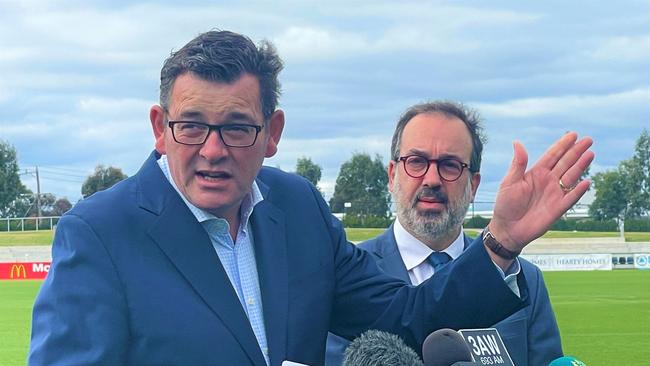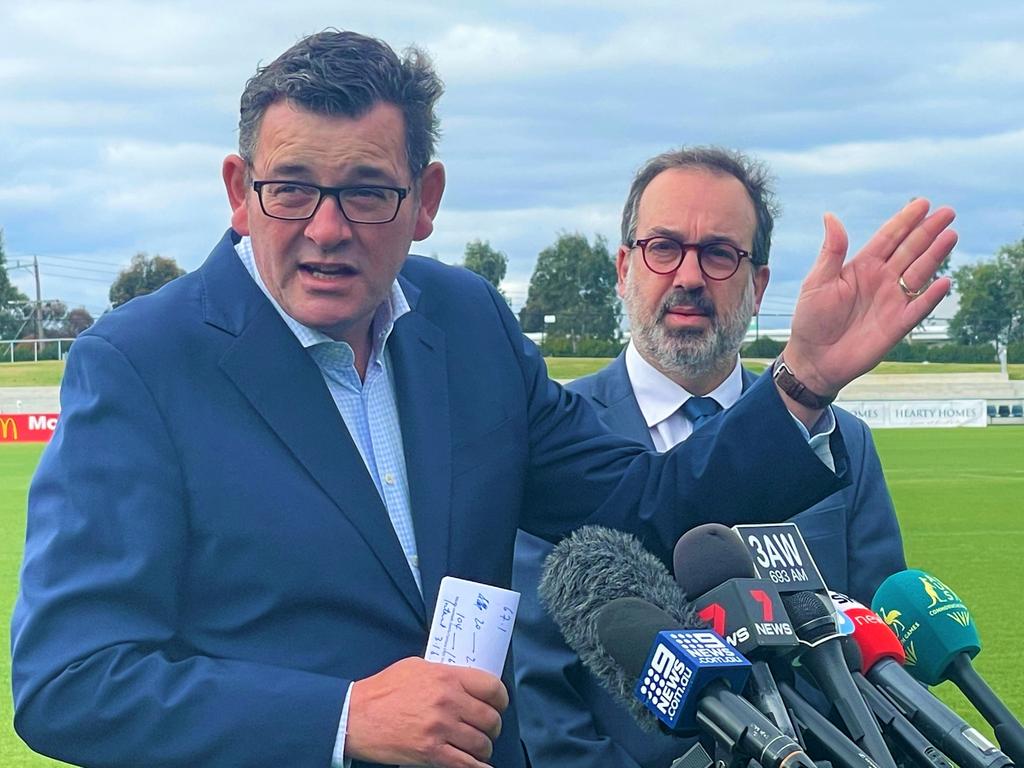‘2034 best’: Commonwealth Games cost blowout warning in 2019
Victoria ignored expert advice to host the Commonwealth Games in 2034 but pushed ahead with a financially riskier and ultimately doomed plan for 2026 | READ THE REPORT

An Andrews government-funded report into staging the Commonwealth Games in regional Victoria recommended hosting the event in 2034 – but Labor pushed ahead with a financially riskier and ultimately doomed plan for 2026.
The report summary, titled Greater Victoria Commonwealth Games bid feasibility study, listed key cost risks and operational problems with a regional Games, including a lack of suitable venues, security costs, other staffing costs and the distance athletes would have to travel to the venues.
The 30-page report, obtained by The Australian, was completed in September 2019 and was co-funded by the Andrews government and regional councils as part of a council-led taskforce pushing for a regional Commonwealth Games initially in 2030, but later focused on 2034.
“The project objectives include: to examine the feasibility or possibility of a regional Victorian bid to host a future Commonwealth Games event in 2034 or beyond,” the report states.
“The funding of this pre-feasibility study has been shared between the Victoria state government and regional Victorian councils. The scope of the pre-feasibility study has been agreed upon by the taskforce and the state government working group, with input provided by regional Victorian councils.”
The 2034 taskforce, made up of council representatives and business leaders, never seriously considered the 2026 Commonwealth Games as a viable option as it felt rushing the event would exacerbate the financial and operational risks identified in the September 2019 report.
Sources familiar with the 2034 taskforce which conceived the idea of a regional Games said the report was shared with a joint council-government working group but was never publicly released.
The source said the 2034 consortium was blindsided by the Andrews government announcing Victoria would host a regional Games in 2026.
“It was our surprise when ’26 got announced as a regional Games because none of us were consulted on that. We had no contact – no idea,” the source said. “We thought this is going to be ambitious to try and get it up. But it was clearly a political ploy at the time.
“(Andrews) was under pressure over a range of things in the lead-up to an election and it was to our great surprise that it was announced as a 2026 option.”
The guiding principle behind the 2034 Games taskforce was that by allowing for such a long timeline, the risks of a cost blowout would be reduced.
“We championed the idea of a regional Games, we were aiming for 2034, not 26, for obvious reasons. We were looking longer term,” one source said.
“We did this pre-feasibility to check the assets, to see what was available. The idea was to do this feasibility to understand where governments were already spending money … so it wasn’t to build new stadiums, and build new facilities. It was to improve projects that were already in play up to 2034 … that were in construction or had funding allocated.
“The whole premise was to try and mitigate this whole cost fiasco by tapping into the existing pipeline of developments.”
The Andrews government has been approached for comment.
Some of the key risks identified in the four-year-old report were similar to those Victorian Premier Daniel Andrews on Tuesday blamed for a $7bn Games bill to justify his dramatic cancellation of the event, which has triggered a global controversy and left Victorians facing a massive compensation bill and the state’s reputation as a sporting capital in tatters.
No apology
In the midst of a political storm over the event’s axing, Mr Andrews visited the northwestern town of Maryborough to sell his regional development fund and attempt to mitigate the chances of a political backlash.
The Premier again refused to reveal how much ripping up the contract could cost taxpayers, as the opposition claimed the compensation bill could hit $1bn.
“No one wanted this thing to cost $5bn, $6bn, $7bn – but those are the best estimates we have,” Mr Andrews said.
“On behalf of Victorian taxpayers, we’re not running that event at that cost.
“I am sorry that we find ourselves here. I’m sorry that we are in this position. But I’m not going to apologise for not taking money out of hospitals and schools – but the easier thing to do is to push on. You’re asking me to apologise for cancelling the Games, but I’m not going to do that.”
Budget time bomb
Budget papers show the government has spent $36m on the Games in 2021-22 and $222m last financial year. Liberal leader John Pesutto has asked the state’s Auditor-General, Andrew Greaves, to investigate how much breaking the contract will cost, why it was so far off the original estimate, how the costs could be so inflated just seven weeks after the 2023 state budget, and how long Labor had known of the budget time bomb.
“To think that Labor may have torched more than one billion dollars is a further indictment on its complete inability to manage money at a time when Victorians are facing unprecedented cost-of-living pressures and essential services are being increasingly stretched,” Mr Pesutto said.
The government is expected to release the costings for the Games after a settlement is reached with Commonwealth Games officials in London. The government is arguing there should not be a major payment to the Games because the bulk of the costs in Victoria were being met by taxpayers.
Litany of challenges
The September 2019 document reads like a broad outline of how the Games model was eventually constructed, including most of the cities, towns or regions that were finally selected.
This includes Ballarat, Bendigo, Ballarat, Shepparton and Gippsland, and it highlighted a series of key logistical issues in 2019 that caused the problems with the bid.
Key Victorian assets such as the athletes’ village in Ballarat had not even started despite the Games being less than 1000 days away.
Andrews cancels Victoria’s standing as a sensible state
The September 2019 report, on page 18 – in a section entitled “venue gaps, weaknesses and issues” – lists a litany of challenges with hosting a regional Games, which sources said underlined the need to host the event in 2034 and not prematurely in 2026.
“The biggest challenge for any major multi-sport event is the provision of an event village and associated accommodation to cater for the demand of athletes close to competition and ceremony venues,” the report states, before it goes on to note “no existing major world class stadium to host athletics with seating for 40,000 spectators” and “limited spectator seating capacity at most regional Victoria venues to meet requirements of the CGF”.
“Many of the current indoor show-courts/competition spaces are not able to be configured for Games program because of roof heights that limit size of spectator stands and/or that don’t meet international competition requirements,” it added.
The report, in a section headlined Weaknesses and issues with the proposed event scenario, notes: “Key deliverable of the Commonwealth Games to bring athletes together both to compete and for cultural exchange is somewhat diluted in a regional Victoria approach. The wide geographical spread of events is likely to be less supported as compared to an event predominantly in a single area.”
Not sustainable
The report also cast doubt on the government’s claim that staging the event in the regions would leave a legacy of first-class venues for the communities.
“The ongoing legacy for regional cities is somewhat diminished because the most viable/effective method of meeting Games infrastructure requirements is through the large utilisation of temporary infrastructure,” the report states. “In many instances, this is a consequence of Games requirements being well beyond that which is sustainable in a regional city.”
Spreading venues across Geelong, Ballarat, Bendigo and Shepparton regions, the report finds, would “require athletes to travel regularly in excess of 60 minutes leading to potentially negative athlete experiences and spectators would be widely dispersed with no central Games hub”.
Satellite villages
The report warns that having as many as 40 per cent of competitors housed in satellite villages, away from the main village, would be required and that this may “see added costs, duplicating accommodation for athletes and officials and transport services across the region adds costs”.
And, the report warns, this could also increase the cost of “sourcing resources like volunteers and contractors”.
It notes that “clustering” the athletes as much as possible could reduce the operating costs as it “reduces travel times for athletes and other Games clients (and) reduces operational costs in key areas including security (and) transport”.







To join the conversation, please log in. Don't have an account? Register
Join the conversation, you are commenting as Logout